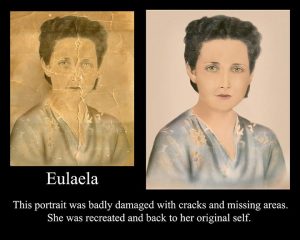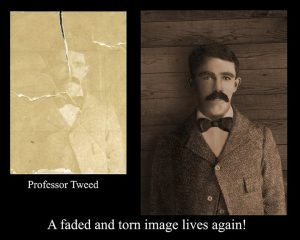Years ago it was fashionable to have family portraits – groups and individual family members. Can’t you remember the groans and complaining when time for ‘family pictures’ rolled around?
Unfortunately, that tradition is not as strong as it once was, primarily because of cell phones and the casual and disposable nature of photo taking today…or so I believe. I worry about what will happen to this current generation and their ability to remember family members that lived before they did. Will cell phones and digital prints last forever? No, they won’t.
I urge you to have images printed and displayed proudly to show your family history and the importance of knowing where you came from. The portraits featured in this presentation were all important to their family members and were preserved for future generations.
Aunt Sally and Uncle Ben were brought into the studio by a customer who had just inherited the canvas portraits of her great-great grandparents. The family member that gave them to her said that she was going to toss them in the trash if she didn’t want them. The canvases on both were in terrible shape but my customer wanted to know if I could reproduce them.
The images were photographed and I began to repair, reprint, and stretch the canvases. In the past, someone had tried to modify the neckline of the lady’s dress by drawing over the original image. We decided which neckline the customer wanted and proceeded with the project.
Eulaela and Santiago were married in South America. Eulaela was on a large canvas that had sustained much damage over the years. The image of Santiago was a tiny print – only 1 x 1.5 inches that had been carried in his son’s wallet for over 25 years! With a good bit of work, I was able to make a 5×7 from the small image. Eulaela was recreated at the original size of 16×20. Their son is a Catholic priest and is very pleased with the restorations. (Side note, I also did a portrait of the Priest, he said he looked like a Bishop – not being Catholic, I am assuming that he was happy with his portrait also.)
John James was brought into the studio by his granddaughter. The original image was scanned in three parts and stitched together digitally before I could begin the restoration. The picture was completely engulfed with white dots covering this man’s distinguished portrait. I could probably work on this image for another 4 or 5 hours to completely remove the dots; however, my customer was happy with the results shown here. I will admit, he does look a little better.
Professor Tweed was also badly damaged with faded inks, cracks and creases. This original image was almost beyond restoration. I don’t know if he was really a teacher or not, but he certainly looks the part. My customer was pleased with the details I was able to get from his faded print. With a lot of work, he’s ready to teach again!
Cherish your ancestors and preserve your heritage. PLEASE don’t store valued family portraits in the attic or basement. You should keep them in a climate controlled area away from extreme heat or cold. If you have cardboard behind images remove it and replace with acid free material. Another way to help preserve images is to hang where there is no direct sunlight.







